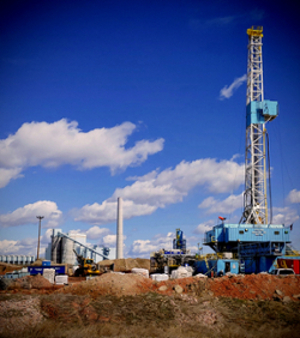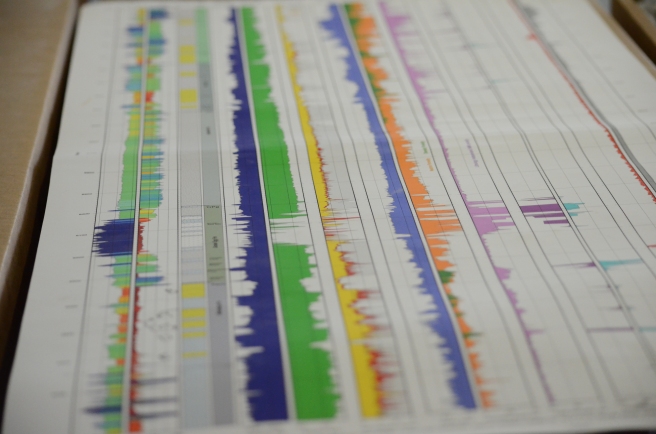
Wyoming CarbonSAFE Project Enters Phase III
Published November 04, 2020
By Christine Reed

Wyoming CarbonSAFE test site located in Campbell County near Dry Fork Station (Basin
Electric)
On Oct. 1, the School of Energy Resource’s (SER) Center for Economic Geology Research (CEGR) at the University of Wyoming officially launched Phase III of the CarbonSAFE project. Funding for Phase III of the project was approved in April of this year where SER and its partners on the project received a $15.4 million award from the U.S. Department of Energy’s (DOE) National Energy Technology Laboratory.
In addition to the $15.4 million in federal funding, project partner Basin Electric Power Cooperative is contributing $1.5 million, and UW’s cost-sharing contribution is $2.4 million.
The Wyoming CarbonSAFE Project, which stands for Carbon Storage Assurance Facility Enterprise, is one of thirteen original carbon capture, utilization, and storage (CCUS) project sites in the U.S. funded by the DOE with the ultimate goal of ensuring carbon storage complexes will be ready for integrated CCUS system deployment. With the advancement of each stage and varying success, fewer sites continued to the subsequent stages. Four of the original thirteen projects have advanced to Phase III, including sites in North Dakota, Alabama, and Illinois. One new project located in New Mexico has joined the program.
Phase I was an 18-month initiative that commenced in 2016 to assess the pre-feasibility of CCUS technology. The Basin Electric Dry Fork Station (DFS) in Campbell County was selected as the project site. Not only is the site ideally located in the Powder River Basin, which accounts for 40% of U.S. coal production, the unique sub-surface geological features in Wyoming allow for optimal potential storage zones. Formations investigated included the Muddy, Lakota, Fall River (Dakota Group), Lower Sundance, and Minnelusa Formations, which are overlain by thousands of feet of impermeable rock that would ensure the permanent containment of carbon dioxide (CO2) fluids in the storage sites.

Beginning in September 2018, Phase II of the project commenced to assess the storage complex feasibility, with major activities including drilling a test well at the site and conducting a 3-D geophysical survey. The test well was completed at a total depth of 9873 feet and 625 feet of core samples from nine different geological formations were collected for analysis. Following the completion of drilling, the team gathered downhole data by running sensors into the hole where they gathered data about the rock layers, fluids in the layers, and pressure within the formations of interest.
October was a pivotal month the project, officially launching Phase III and wrapping up data collected in Phase II. Phase III project objectives are to finalize site characterization, complete Class VI permitting to construct, integrate Membrane Technology and Research, Inc.’s (MTR) CO2 capture assessment, and conduct National Environmental Policy Act (NEPA) analyses to advance towards the eventual commercialization of a large-scale (storing 50 million metric tons of carbon dioxide within a 30 year period) CCUS project at Dry Fork Station.
If the projected success of Phase III comes to fruition, then the venture will advance to Phase IV of the initiative for permitting and the construction of an actual storage complex.
”Phase III will be the phase that tees up commercial operation, at the study site but also for other areas in Wyoming,” says Scott Quillinan, director of CEGR. “By the completion of Phase III, the project team will have finalized all site characterization and Class VI permitting activities, thereby leaving the project poised to begin final commercialization actions with the consent of project partners. In so doing, the project will have commercially advanced CCUS technologies both in terms of reservoir characterization in the CO2 storage context, and in obtaining the first Class VI permit to construct in the State of Wyoming so that others may follow suit.”
The Environmental Protection Agency (EPA) recently approved the application, allowing Wyoming to have permitting authority for Class IV wells.
By achieving primacy, Wyoming will be a haven for operators that want to take advantage of the 45Q tax credit that was extended and expanded through a bipartisan effort co-authored by Wyoming Senator John Barrasso, the Furthering Carbon Capture, Utilization, Technology, Underground Storage, and Reduced Emissions (FUTURE) Act. The tax credit incentivizes utilities and other industrial sources to build-out carbon capture, utilization, and sequestration (CCUS) projects, including Class VI wells.
“Not only is Wyoming one of the test sites that is ahead of the curve in terms of the actual feasibility of CCUS technology, we believe the ability to work directly under the guidance and regulatory oversight of the Wyoming Department of Environmental Quality makes the possibility of developing a commercial CCUS project more feasible in the state of Wyoming,” adds Quillinan.
Other major participants and partners in the Wyoming CarbonSAFE project include: Basin Electric Power Cooperative; Energy & Environmental Research Center; Advanced Resources International, Inc.; Carbon GeoCycle, Inc.; MTR; Denbury Resources Inc.; UW Enhanced Oil Recovery Institute; UW College of Business; UW College of Law; Los Alamos National Laboratory; and Schlumberger.
